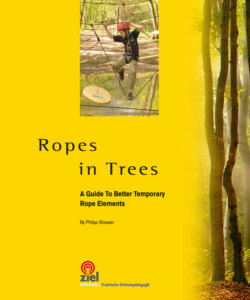Читать книгу Ropes in Trees - Philipp Strasser - Страница 10
На сайте Литреса книга снята с продажи.
What Is a Temporary Rope Element or Temporary Rope Course?
ОглавлениеThe European construction standards (EN 15567, effective since 2008) define the terms and distinguish between static rope courses, mobile rope courses, and temporary rope elements.
Static rope courses are amusement rope courses or forest rope courses secured by self-belay, rail systems, semi-continuous systems (e.g. SBB system) or top rope. Static rope courses are also defined by the standard as seminar rope courses and installed seminar elements like “Pampers Pole” or “Giant Ladder” which are normally secured by top rope or N belay.
Mobile rope courses can be set up at different locations. Mobility means that the supporting structure is mobile, such as steel or wood scaffoldings where seminar or amusement courses can be installed. Various set up versions exist for seminar elements, such as “Pampers Pole” or “Giant Ladder.” Other concepts prefer quick mounting of amusement rope courses with several elements in a row at exhibitions or other events, such as the Burma Bridge or multiline traverses. These rope courses must meet the standard requirements.
Temporary rope courses or temporary rope elements are usually set up between trees or other non-mobile structures in a short period of time, for a limited period of time. They are completely dismounted after use. The trees and structures should be left in their original condition after use.
If the course is set up for less than seven days, it is not considered to be under the rope course standard. This means that they do not need to be released by a certifying authority like other rope courses and the sling points do not need to be checked by structural engineers or arborists. Regarding due diligence, every constructor must apply the most updated expertise regarding materials, sling points, and all other criteria, even if they do not have to be inspected by external officials. In case of an accident, the European construction standard may be referenced by accident investigators.
Temporary rope elements consist of the support system (poles, trees), the activity element, and a safety element (if the participants are lifted more than half a meter above ground level.) For elements less than half a meter from the ground, no safety element is required. The standard does not distinguish between high and low elements but refers to “adequate safety measures.”
“Low elements” are elements where the participants do not wear belays but are secured by other persons. “Low elements” might be covered under playground standards EN 1176 and EN 1177. The difference between a playground and a rope course is that a playground is a public domain and may be used without supervisors. Strictly speaking, an unsupervised and accessible temporary rope element must meet the playground standards. These standards define that there must be no risk of getting stuck or trapped. There must be no sharp edge, which means ratchet snaps must not be applied. EN 1177 defines the height of playing elements and the underlying dampening ground. It can be applied as a manual when securing rope elements.
“High elements” are elements that require participants to wear harnesses, and are secured from falling by several belay ropes.
Support System
The support system is the part of the construction to which the activity element and the safety elements are attached. For temporary rope elements, these are typically trees but can be other fixation points like rocks or buildings.
The support system must resist the same forces as the suspension points, such as heavy duty round slings and carabiners. Trees can be guyed for additional support.
Safety Element
Safety elements are those parts of the element that prevent the participants from injury in case of a fall. A safety element like top rope can also serve to abseil a participant or to support him while ascending the element. Low elements usually have no safety elements since they are already secured by other conditions, like underlying water or soft ground. High elements are secured with canopies with top rope or N belay.
Activity Element
The activity element is the element itself. Safety requirements should protect participants against injury while using the element. For example, boards must not have sharp edges and low lashing straps should be secured. No parts of the activity element must harm passive participants or damage the ground if components fall.
